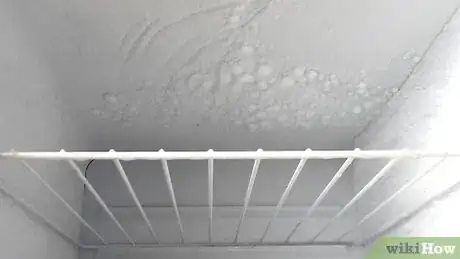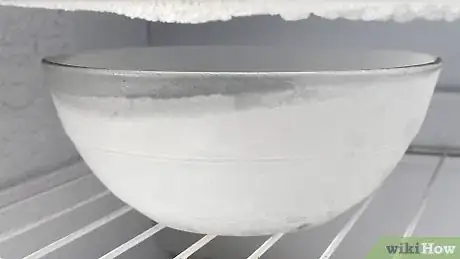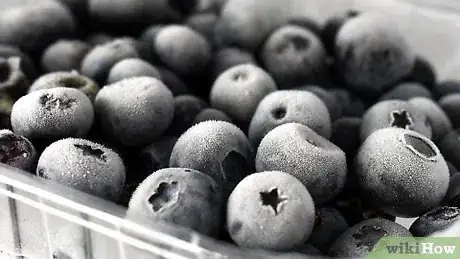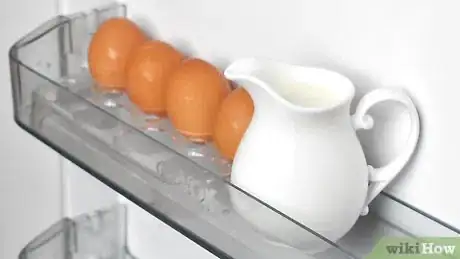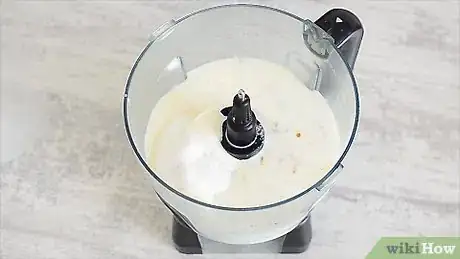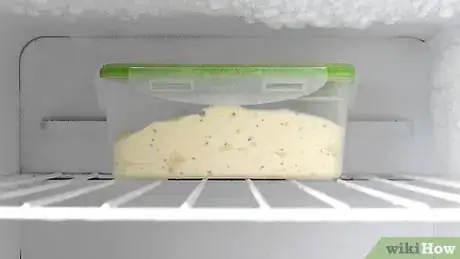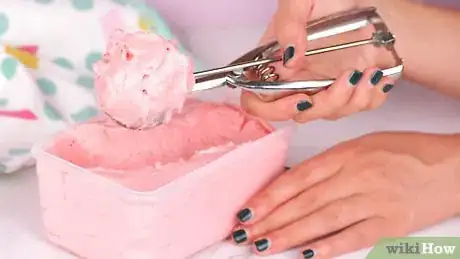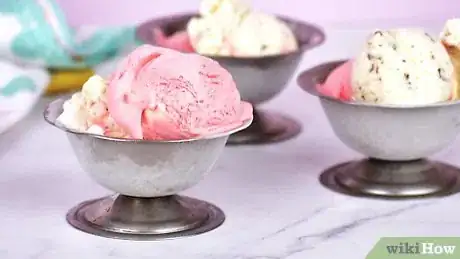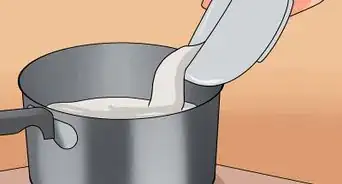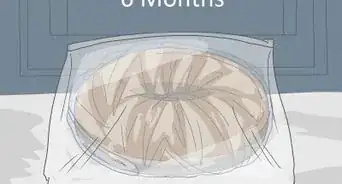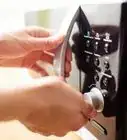This article was co-authored by wikiHow staff writer, Eric McClure. Eric McClure is an editing fellow at wikiHow where he has been editing, researching, and creating content since 2019. A former educator and poet, his work has appeared in Carcinogenic Poetry, Shot Glass Journal, Prairie Margins, and The Rusty Nail. His digital chapbook, The Internet, was also published in TL;DR Magazine. He was the winner of the Paul Carroll award for outstanding achievement in creative writing in 2014, and he was a featured reader at the Poetry Foundation’s Open Door Reading Series in 2015. Eric holds a BA in English from the University of Illinois at Chicago, and an MEd in secondary education from DePaul University.
There are 7 references cited in this article, which can be found at the bottom of the page.
The wikiHow Culinary Team also followed the article's instructions and verified that they work.
This article has been viewed 31,353 times.
Learn more...
Homemade ice cream is a delicious treat, but if you don’t make it right, you may end up with chunks of ice in every bite. Ice forms on homemade ice cream due to crystallization, and this process is usually triggered when you don’t freeze your ice cream fast enough. Your recipe and storage method may contribute to crystallization as well. This is the most common problem that ice-cream-making enthusiasts face, so don’t be too hard on yourself if your first attempt to make ice cream ends up a little frostier than you’d like.
Steps
Keeping Your Ingredients Cold
-
1Set your freezer to the coldest temperature before you make ice cream. Open your freezer a day or two before you plan on making your ice cream and turn the temperature dial to the coldest setting available. If you have a digital control panel on your freezer, use that to turn the temperature down instead. The colder you make the freezer, the less likely you will be to run into ice crystals forming on your ice cream.[1]
- If you don’t have control over the temperature of your freezer or your freezer is already as cold as it can get, don’t worry about it. There are plenty of other ways to keep things cold!
- The goal here is to get the ice cream to freeze as fast as possible. The longer the ice cream sits unfrozen, the more time the moisture in your ice cream has to form ice crystals.
-
2Leave your mixing bowl in the freezer for 24 hours ahead of time. Nearly every homemade ice cream recipe requires a large bowl where you mix your ingredients. Freeze this bowl for 24 hours before making your ice cream so that your ingredients start freezing as soon as you pour them into the bowl. If you plan on transferring your ingredients from a mixing bowl to another dish before putting it in the freezer, freeze that too.[2]
- The same applies to your ice cream maker if you’re using one. Set the ice cream maker inside of your freezer 24 hours before you make your ice cream. Don’t worry about damaging the components—the machine is designed to get cold![3]
- It probably doesn’t make a big difference, but you may get fewer ice crystals if you freeze the ice cream in a wide, shallow dish instead of a giant bowl.
Advertisement -
3Freeze any solid ingredients you plan to mix in for 8-12 hours. If you’re adding brownie bites, cookie dough, sprinkles, or chocolate chips to your ice cream, set the ingredients inside of your freezer the night 8-12 hours before you plan on making your ice cream. This way, your mix-ins will be colder than the other ice cream ingredients when you add them to the mixture.[4]
- If the ingredients you’re mixing in are at room temperature, they may keep the ice cream from freezing as fast as it otherwise would. The longer it takes the ice cream to freeze when you place it in the freezer, the more likely it will be to crystallize.
-
4Chill liquid ingredients in the refrigerator for 12 hours before using them. Refrigerate any liquid ingredients you’re using for at least 12 hours before you make your ice cream. This will give the cream, milk, or water time to cool, which will reduce the amount of ice that ends up on your ice cream once you take it out of the freezer.[5]
- You don’t need to do this if you’re making custard-based ice cream since you’re going to heat the ingredients before freezing the ice cream anyway.
- If you’re in a rush or you forgot to chill your ingredients, pour your liquid ingredients into plastic food storage bags and give them an ice bath for 20-30 minutes.
-
5Let your ice cream maker run for 15 minutes so it gets cold. If you happen to have one of those ice cream makers that churn the ingredients for you, take it out of the freezer and turn it on for at least 15 minutes before you start adding or mixing any ingredients. This will give the ice cream maker time to get as cold as possible before you start adding anything.[6]
- Don’t worry about the bowl spinning inside without anything in the machine; you won’t damage your ice cream maker by doing this.
Choosing and Making Your Recipe
-
1Opt for custard-based recipes over Philadelphia-style options. The two most popular homemade ice cream styles are Philadelphia-style and custard-based. Custard-based options require eggs, which helps the ice cream freeze firm, while Philadelphia-style ice cream doesn’t. As a result, the custard-based recipes are much better if you want creamy, ice-free ice cream.[7]
- Sicilian-style ice cream, which utilizes cornstarch to thicken the ice cream, is also a great option if you’re trying to keep ice out of your ice cream. Unfortunately, cornstarch starts to break down when it’s frozen, so eat your ice cream sooner rather than later if you go this route.[8]
-
2Choose waterless recipes or cut back on the water required. If you make a water-based recipe and it turns out icy, cut the water in half the next time you make the ice cream. Even better, choose a recipe that doesn’t involve water at all. The more water there is in your ice cream, the more likely it will be to form ice crystals.[9]
- You can normally swap out water for coconut milk or heavy cream. It may depend on the recipe or what your dietary restrictions are, though. Most people make homemade ice cream with water to avoid dairy, so you may not be able to change anything out.
-
3Add liquor to the recipe for a fun, adult version that won’t ice over. Use roughly 1–2 tablespoons (15–30 mL) of liquor for every 1 US quart (0.95 L) of ice cream that you’re making. Alcohol will keep the ice cream from crystallizing, and it will add a dynamic flavor you’re looking for a boozy, creamy treat. Vodka will be pretty hard to detect, while rum is a great option for anything with raisins or cinnamon in it. Bourbon and scotch are fun options as well.[10]
- This should keep any recipes with water in them from icing over as well.
-
4Measure your sugar and fatty ingredients carefully and don’t adjust them. Most homemade ice cream recipes that you find online require a sugar and a fat (usually from cream or eggs). Do not modify these ratios and measure these ingredients out carefully. If there isn’t enough sugar or fat, or one of the ingredients overpowers the other, the ice cream may end up coagulating or separating as it freezes. This will give ice crystals plenty of space to form on your ice cream.[11]
- You may be able to get away with using more sugar, cream, or egg, but it’s generally better to stick to the recipe until you’ve mastered ice-free ice cream.
-
5Transfer the ice cream to the freezer as fast as possible once it’s mixed. Clear a space out in your freezer for the ice cream ahead of time so that you aren’t fumbling around to make room. Open the freezer before you start mixing, or have a friend or family member open the freezer for you to make the transfer seamless. Once you’ve mixed your ice cream or finished running your ice cream maker, get your ice cream in the freezer as fast as you possibly can![12]
- If the ingredients have time to sit out at room temperature, the cream will coagulate together and leave large chunks of water that are highly likely to crystallize.
Storing and Eating Your Ice Cream
-
1Set the ice cream in the back of the freezer to keep it as cool as possible. Since the freezing air comes in from the back of the freezer, the very back of the freezer is a few degrees colder than the front half. As a result, your ice cream is more likely to end up creamy and delicious if you set it against the very back of the freezer.[13]
- If you’re using one of those chest-style freezers, set your ice cream at the bottom.
-
2Cover your ice cream with plastic wrap to prevent freezer burn. After you place the ice cream in the freezer, cover it with plastic wrap. This will keep the top layer of ice cream from getting freezer burn, which can cause ice crystals to form.[14]
- You can always set a plate or flat object on top of the ice cream to protect it if you prefer.
-
3Let the ice cream sit out for 5-10 minutes before eating it. When you’re ready to eat your ice cream, take it out and set it on the counter or table for 5-10 minutes. Any ice crystals that are sitting on the surface of your ice cream will dissipate and the ice inside of the ice cream will soften up considerably. It will also make your ice cream a little creamier, and you’re more likely to enjoy it![15]
-
4Microwave your ice cream for 10 seconds before eating it if it’s visibly icy. If you see ice crystals sticking all over your ice cream when you take it out of the freezer, throw it in the microwave and zap it for 10 seconds. Then, check on your ice cream. If there’s no ice, it’s ready to go! If you still see a little ice, microwave it for another 5-10 seconds. Keep doing this until you don’t see any ice on your ice cream and enjoy![16]
- If the ice melts, you won’t have that frustrating crunch with each bite. Microwaving ice cream may mess with the texture a little, but it’s better than biting into a chunk of ice every time you go to take a bite!
References
- ↑ https://www.thekitchn.com/keep-your-cool-the-best-way-to-store-homemade-ice-cream-tips-from-the-kitchn-205444
- ↑ https://food52.com/blog/13333-5-common-homemade-ice-cream-issues-how-to-fix-them
- ↑ https://whatscookingamerica.net/KellyPatey/ElecIceCreamMaker.htm
- ↑ https://theweek.com/articles/856109/secrets-making-perfect-ice-cream
- ↑ https://www.dreamscoops.com/tips-and-tricks/troubleshooting-homemade-ice-cream
- ↑ https://www.dreamscoops.com/tips-and-tricks/troubleshooting-homemade-ice-cream/
- ↑ https://theweek.com/articles/856109/secrets-making-perfect-ice-cream
- ↑ https://theweek.com/articles/856109/secrets-making-perfect-ice-cream
- ↑ https://www.dreamscoops.com/tips-and-tricks/troubleshooting-homemade-ice-cream/
- ↑ https://theweek.com/articles/856109/secrets-making-perfect-ice-cream
- ↑ https://www.dreamscoops.com/tips-and-tricks/troubleshooting-homemade-ice-cream/
- ↑ https://food52.com/blog/13333-5-common-homemade-ice-cream-issues-how-to-fix-them
- ↑ https://www.thekitchn.com/keep-your-cool-the-best-way-to-store-homemade-ice-cream-tips-from-the-kitchn-205444
- ↑ https://whatscookingamerica.net/KellyPatey/ElecIceCreamMaker.htm
- ↑ https://theweek.com/articles/856109/secrets-making-perfect-ice-cream
- ↑ https://food52.com/blog/24335-how-to-make-ice-cream
